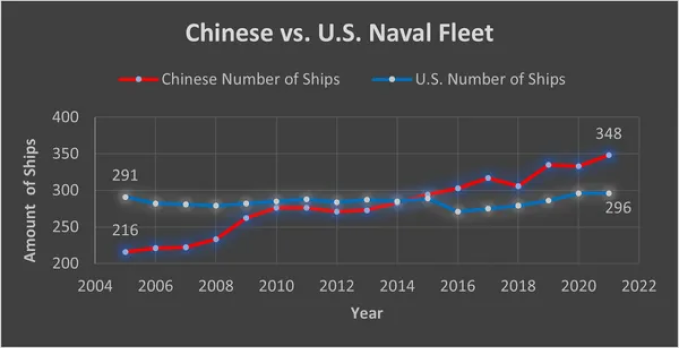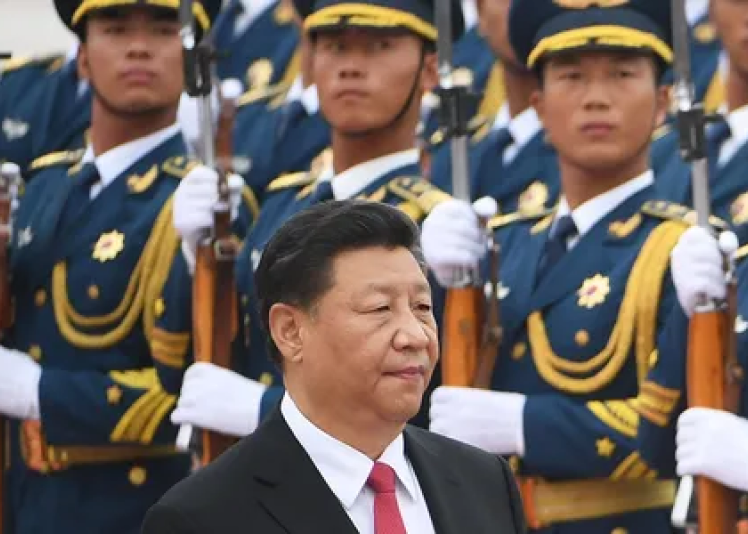Key Points
- The Chinese military, known as the People’s Liberation Army (PLA), combined with China’s economic and information warfare presents the most capable and aggressive threat to U.S. interests and security in our nation’s history. Worse, the Biden Administration is not meeting the challenge.
- The Chinese military nuclear build-up is occurring at a rapid pace, far exceeding original U.S. intelligence and Pentagon predictions. In 2020 the United States predicted that China would hold 400 nuclear warheads by 2030. A year later, the same U.S. prediction skyrocketed to 1,000.
- The ultimate goal of the Chinese Communist Party (CCP) is to overtake the U.S.-led order of freedom and democracy and replace it with an authoritarian China-centric order in Asia that uses military coercion to advance the CCP’s interests.
- The Biden Administration recognizes this threat but so far has failed to fund the U.S. military at the necessary rate to keep pace with China’s advances, nor has it prioritized Great Power Competition as administrations of both parties focused on the Middle East and other theatres. Biden refuses to develop a military capable of deterring the CCP’s aspirations, leaving Americans and our allies more vulnerable to China’s authoritarian rule.
Overview
- Two decades ago, the PLA was a low-technology, ground-centric force that steadily operated below the United States’ military across every metric, following Deng’s direction to modernize the economy and agriculture first.
- Since then, the CCP has steadily modeled itself after the US military, leveraging access to our military technology to transform the PLA from a bloated, poorly funded force into a high-tech “informationized” force capable of synchronizing air, naval, ground, and high-tech cyber forces. The CCP excels in missile technology and has shaped their force structure specifically to counter U.S. military power.
- In 2021, the Pentagon revealed that China is equal to or exceeds the United States in shipbuilding, land-based ballistic missiles, and integrated air defense systems.
- China’s strategy is based on countering specific U.S. advantages, particularly our more advanced air and maritime capabilities. In direct conflict, China would target U.S. aircraft carriers in an attempt to handicap the United States’ strongest advantage.
- The PLA’s first priority is domestic control; it exists to keep the CCP in power. After that, its focus is forced capture of Taiwan, with the goal of preventing US intervention (A2AD). Recent positive commitments from Japan have complicated the PLA’s plans.

Chinese Naval Build-Up
- Chairman Xi Jinping tasked the Chinese Navy (PLAN) along with the entire military to become a world class global force by 2049. Currently, the U.S. Navy dominates the sea, guaranteeing protection for international shipping, securing free trade routes, and sustaining order in the world.
- The growing Chinese Navy poses a direct threat to the freedom of navigation guaranteed by the United States. The Chinese Navy already has more warships than the U.S. Navy and constructs new warships at a rate far outpacing the U.S. capability.
- As a global force, US resources are spread out while the PLA is allowed to focus on Taiwan and the South China Sea.
- In 2020, China had 347 warships in its navy, whereas the United States sailed 297. By 2025, the U.S. expects China to possess 400 vessels while we will have 313.
- Raw numbers do not capture qualitative differences, but mass has a quality all its own.
- CCP leaders in 2015 highlighted this important shift in their strategic outlook, writing that “The traditional mentality that land outweighs sea must be abandoned, and significant importance has to be attached to managing the seas and oceans.”
- Though the Chinese Navy outpaces the quantity of U.S. ships, the United States will maintain superiority in quality of capital ships for the near-term. For instance, the United States projects a global naval-air force with 11 aircraft carriers, while China only has two carriers that are far inferior. The U.S. Navy also has 92 naval destroyers capable of shooting long-range missiles, whereas China has 32.
- President Trump recognized the growing Chinese navy as a problem and championed a rigorous fleet expansion to bring the U.S. Navy to 400 ships within 20 years. President Biden foolishly attempted to reverse course, and reimplemented anemic Obama-era defense policies and spending. Thankfully, his own Democratic counterparts in Congress sided with President Trump’s vision for a strong U.S. Navy in the Navy’s 2022 budget.
Chinese Army Build Up
- The Chinese army has the largest ground force in the world with 975,000 soldiers. The U.S. Army maintains 480,000 active-duty soldiers.
- The Chinese army operates the world’s largest tank force with 7,000 active tanks. Comparatively, the U.S. Army has 2,000 active tanks, while the U.S. Army Reserves has 4,000 tanks. In 2018, the Chinese army introduced a battle tank capable of traversing mountains and difficult terrain, adding to their large force. This tank gives the CCP greater power to wage operations against India on the precarious Chinese- Indian border in the Himalayan mountains.
- The United States is unlikely to face the Chinese Army in combat, but its strength remains relevant in potential use against their neighbors.
Chinese Air Force Build Up
In 2019, the CCP directed the Chinese Air Force for the first time to prepare for offensive missions. China now seeks to dominates the sky in their region, launching many training exercises in Southeast Asia. The Pentagon’s 2021 report on the PLA’s capability acknowledged that the Chinese Air Force has made up significant ground against the U.S. air advantage.
Previously unable to build advanced fighter planes, the CCP stole significant amounts of aircraft technology from the United States and our allies. The modern Chinese Air Force fleet consists of fighters (comparable to F-15 & F-35’s), bombers, reconnaissance planes, and unmanned aerial vehicles (UAV/drones), giving the CCP the ability to fight against the United States in direct air-to-air combat.
- The PLA now has 800-fourth generation fighter jets, similar to the U.S. F-16 fighter jet.
- The PLA possesses 450 bombers/attack aircraft capable of conducting precision strikes as far as Guam and holding nuclear payloads as well.
- We have so far successfully denied the Chinese Air Force the engine technology it desperately needs, but the gap is closing.
China uses its Air Force to intimidate Taiwan by aggressively flying military planes in Taiwan’s Air Defense Identification Zone and has the power to quicky air raid the island in a potential conflict.
- This is reckless and unnecessarily provocative as it puts Taiwanese and Chinese fighter planes in close proximity, increasing the chances of accidental shoot-downs
- The day Putin invaded Ukraine, the CCP flew nine fighter jets in Taiwan’s ADIZ causing the Taiwanese military to abruptly scramble its air force.
- The U.S. Defense Intelligence Agency declared in 2017 that the Chinese Air Force accepted a nuclear mission, rounding out China’s strategic Triad. This allows China to further intimidate Taiwan and attempts to deter Taiwanese allies from coming to the country’s aid.
Since the onset of Biden’s presidency, the emboldened CCP flew more planes into Taiwan’s Air Defense Identification Zone than in any point in recent memory
- This means that PLA military planes, including fighter jets and nuclear capable bombers, flew dangerously close to Taiwan and purposefully avoided identifying themselves to Taiwanese air authorities.
- It also presents a threat to peaceful civil flights in the region, putting civilian lives at risk.

Chinese Nuclear Build-Up
- The size of Russian and U.S. nuclear stockpiles was constrained by arms control treaties that Russia has since abandoned but the Biden Administration refuses to leave. However, China refuses to cooperate or negotiate any limitations to its nuclear stockpile size amid their rapid buildup.
- China successfully tested a hypersonic missile in 2021.
- Hypersonic missiles give the PLA the ability to send conventional or nuclear warheads almost anywhere in the world in minutes with greater maneuverability than current air defense systems can counter.
- China’s nuclear build-up is on pace to quadruple inventory by 2030 according to Department of Defense predictions.
Biden Fails to Address the Problem
- Chinese calculations and strategic planning for future attacks are carefully developed by watching U.S. and Western responses to other crises around the world. Under Biden’s watch, the Taliban overtook Afghanistan and Russia invaded Ukraine with no willingness to devote U.S. forces in response. The CCP has observed Biden’s weakness and is becoming more emboldened to launch operations against Taiwan.
- The U.S. needs to dramatically increase our military spending and posture in the Asia-Pacific in order to deter a Chinese attack against Taiwan – while working to further train and equip the island to defend itself. Otherwise, we risk losing yet another democracy to the clutches of authoritarianism.

